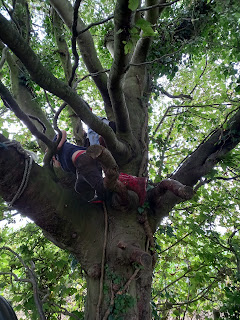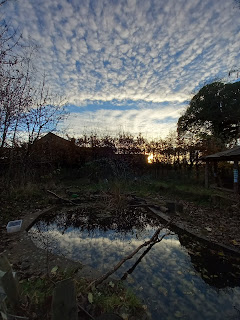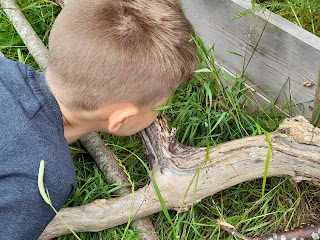Good Week/Bad Week
It's been a very mixed week.
The language it has generated has been highly mathematical, the cooperation and collaboration has been amazing, and their creativity has blossomed.
I ignored my own Cardinal Rule for all outdoor learning: if it can be done inside then do it there, outside is for all the stuff you CANNOT do indoors!
The children started making art on the floor last week, so this week I gathered resources for them to use.
The option to create patterns and pictures was there for them to explore, with some examples of the work by Hannah Bullen Ryner and James Brunt for inspiration.
Children from all year groups had a go, and when James Brunt responded on Twitter to their photos they were thrilled!
Using Nature's windfalls gave the opportunity to further discuss why we never taste anything we find, as well as the chance to explore the colours of berries and leaves, cones and petals...
It was also the best way to get up close and personal with the properties of these, working out how to incorporate the 3D pine cones and the rolling Hawthorn berries onto a flat surface.
Plus the children we amazed at the berry of the Spindle Tree close up, the colours and the shape. Yes, we know it is poisonous. It's the first thing most children ask about anything they find, be it berry or bug, the standard answer is 'only if you eat it'! We have a strict 'No Pick, No Lick, It Will Make You Sick' rule that every child in the school can recite!
There is a renewed appreciation of the small details around them, tangible excitement when they find something they want to use, and some brilliant sharing and helping and communicating.
Despite the disruption of covid on the last two academic years, the constant of Forest School means the children have slowly built up their understanding of what they can enjoy outside.
Each term I try to introduce something new, as well as revisit old independent activities, to encourage them to try something different, and to broaden their experiences.
As we head into our third year of doing Forest School this way, the pupils we have are very used to this way of working, they settle quickly in a session, and are truly free range, only calling on adult support when they need it.
Occasionally I step away from the child led ethos of Forest School and introduce something out of the blue! It rarely ends well!
My ideas will never compete with theirs, their investment in their own is too big to to be dwarfed by mine!
Lots of the lovely instagramable activities that are so tempting to try have a big flaw in that they are rarely independent.
This week I started to make 'Eyes of Light' with a group, and soon ended up trapped at basecamp overseeing how to tie a lashing and create a loop.
I quickly had a queue of children who were amazingly patient but spent way too much of their time waiting for their turn when they couldve been bug hunting, tree climbing, digging, talking to friends, and exploring nature.
My focus was on an ever changing but never ending group of about 5 or 6 children.
Now and then I would excuse myself and go and wander around to see what everyone else was doing but this felt more like patrolling as interaction with them was limited, I was inevitably called back to basecamp to help those starting or completing their little hanging 'star'.
I was not outside alone, if I was I could never have contemplated an activity that took up so much of my attention - or I would have to reduce the opportunities or space the children can explore. But leaving one person to oversee what the remaining 20+ children were doing forced the adult into patrol mode also.
What makes Forest School work well for us is being able to offer direction, suggestion and support, with adult interaction extending the childrens experience. Introducing new ideas, questioning children, drawing information from them, helping them to think critically. Their child-led, independent learning happens within a structured environment that nurtures it, and it struggles once that structure is abandoned.
Nothing terrible happened. No injuries, mostly because the children are trained to keep themselves safe! But some minor damage to tools, and some digging in an inappropriate area, both incidents with classes that 'should know better', but both also happening while groups were highly excited at the mass of mud in the Dig Pit - enthusiasm will always waiver acting sensibly!
The next day the weaving stayed in the shed, some children from a different class stopped their game and came to help rectify the damage. Order was restored, and I was reminded why I choose to provide opportunities and, for want of a better phrase, 'facilitate learning' rather than 'teach' a specific task.
It works so much better, the children get so much more out of it, and so much more learning occurs.
Sadly that little hiccup was not the low point of the week. I arrived today to find that someone/some people had trespassed on school grounds and overturned everything in basecamp. It wasn't 'damaged just a huge mess. Fixing it eats into my prep time, cataloging it in case of future issues takes time, reporting it to the site manager and head teacher, keeps me from setting up, and does not start me off in a good mood for the day!
The worse effect is how it makes me question the community we are in.
I'm fortunate/unfortunate enough to know it won't last because it happens, to some extent or another, way too often.
However I refuse to end the week feeling annoyed!
Not that it's possible once the children arrive.
Today the last 3 classes of the week took their opportunity to create art. They also helped each other climb trees, they chatted and played rocks and crosses, they got muddy enough to need to be hosed down, they smiled, they laughed, and they explored.
Which is just how it should be.
















Comments
Post a Comment